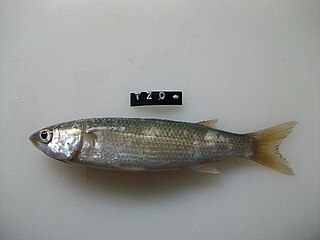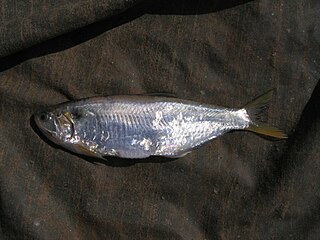Francis Buchanan, later known as Francis Hamilton but often referred to as Francis Buchanan-Hamilton, was a Scottish surgeon, surveyor and botanist who made significant contributions as a geographer and zoologist while living in India. He did not assume the name of Hamilton until three years after his retirement from India.

George Albert Boulenger was a Belgian-British zoologist who described and gave scientific names to over 2,000 new animal species, chiefly fish, reptiles, and amphibians. Boulenger was also an active botanist during the last 30 years of his life, especially in the study of roses.

Léon Louis Vaillant was a French zoologist. He is most famous for his work in the areas of herpetology, malacology, and ichthyology.
Victor Gruschka Springer was an American biologist who was a Senior Scientist emeritus, Division of Fishes at the Smithsonian Institution's National Museum of Natural History in Washington, D.C. He was a specialist in the anatomy, classification, and distribution of fishes, with a special interest in tropical marine shorefishes. He published numerous scientific studies on these subjects; also, a popular book called "Sharks in Question, the Smithsonian Answer Book" 1989.

The South African mullet, also called a harder mullet or simply harder, is a species of mullet. It is found in South African coastal waters from Walvis Bay (Namibia) to KwaZulu-Natal, and grows to a maximum length of 40.5 cm (15.9 in). The person the specific name honours was not recorded by Andrew Smith when he described this species but it is most likely to be John Richardson (1787-1865), the Scottish naturalist, surgeon and Arctic explorer.

The bobo mullet, is a species of ray-finned fish of the mullet family Mugilidae. It is the only species in the genus Joturus, one of 17 mullet genera containing altogether about 80 species of ray-finned fish. It occurs in rivers, including brackish waters, in much of the Gulf of Mexico basin from Mexico as far south as Panama and the Caribbean coast of Colombia, as well as the West Indies and the United States state of Florida. The specific name honours the Cuban lexicographer and geographer Esteban Pichardo (1799-1879).
George Sprague Myers was an American ichthyologist who spent most of his career at Stanford University. He served as the editor of Stanford Ichthyological Bulletin as well as president of the American Society of Ichthyologists and Herpetologists. Myers was also head of the Division of Fishes at the United States National Museum, and held a position as an ichthyologist for the United States Fish and Wildlife Service. He was also an advisor in fisheries and ichthyology to the Brazilian Government.

Agonostomus telfairii is a species of ray-finned fish in the family Mugilidae, the mullets. It is known by the common name fairy mullet. It is native to the islands off the eastern coast of Africa, where it can be found in freshwater bodies and estuaries in Comoros, Madagascar, Mauritius, Mayotte, and Réunion. It returns to the sea to spawn.
Maurice Kottelat is a Swiss ichthyologist specializing in Eurasian freshwater fishes.
The Kottelat rasbora is a species of ray-finned fish in the genus Rasbora. It is found in Asia - eastern Myanmar, northern Thailand and the Mekong basin.

Osteobrama belangeri is a species of ray-finned fish in the genus Osteobrama. It was found in the Indian state of Manipur, but has been extirpated there and as of 2022 is found in the wild only in Myanmar. Farmed populations in Manipur and wild-caught fish from in Myanmar are used as food. The extirpation from Manipur was caused by dam building, habitat degradation and the introduction of alien species which caused the populations to fragment.

Mugil thoburni, Thoburn's mullet, is a species of grey mullet, from the family Mugilidae, found in the eastern Pacific Ocean. It is most common around the Galapagos Islands but does occur on the coasts of Central America and South America as well. This species grows to a length of 29.5 centimetres (11.6 in) TL. It was formerly regarded as the only known member of the genus Xenomugil.
Pseudambassis roberti is a species of ray-finned fish in the family Ambassidae, the Asiatic glassfishes. It is sole species in the genus. It is endemic to Burma. The Catalog of Fishes classifies this species as Parambassis robertsi. The specific name honours the American ichthyologist Tyson R. Roberts.
Gerald Robert "Gerry" Allen is an American-born Australian ichthyologist. His career began in 1963, when he spent a semester at the University of Hawaii, where he also received a PhD in marine zoology in 1971. In 1972, Allen wrote his doctoral thesis on the systematics and biology of the anemone fish.

Thryssa hamiltonii, or Hamilton's thryssa, is a species of ray-finned fish in the family Engraulidae. The species is found in the tropical western Indo-Pacific region: mainly, the eastern direction near Myanmar, Taiwan, the northern head of Australia and Papua New Guinea and possibly the Philippines.
Agonostomus catalai, the Comoro mullet, is a species of ray-finned fish, a mullet from the family Mugilidae. It is found in the Comoros and Madagascar where it is found in boulder strewn clear, fast flowing rivers, it may also occur in estuaries, It is eaten in Madagascar. The specific name honours René Catala (1901-1988) who was a coffee planter and biologist who collected type in Madagascar. It lays non adhesive, floating eggs.
The Diassanga mullet is a species of ray-finned fish, grey mullet from the family Mugilidae. It is found in the eastern Atlantic around the coasts of West Africa.
The pinkeye mullet, also known simply as pinkeye, or freshwater mullet, Richmond mullet, or river mullet, is a species of ray-finned fish from the grey mullet family Mugilidae and the only species in the genus Trachystoma. It is endemic to northeastern Australia where it occurs from the Burnett River in Queensland to the Clyde River in New South Wales. It is a subtropical species which is found in deep, slow flowing sections of rivers as well as in estuaries although it moves into coastal seas to spawn. It feeds mainly on algae and plant material, as well as detritus and benthic invertebrates.
Psilorhynchus olliei is a freshwater ray-finned fish, from Kyari Chaung, Ayeyarwady drainage in Myanmar. This species reaches a length of 5.4 cm (2.1 in).

Crenimugil buchanani, the bluetail mullet, is a species of ray-finned fish in the family Mugilidae. It is found throughout the Indo-Pacific Ocean.









